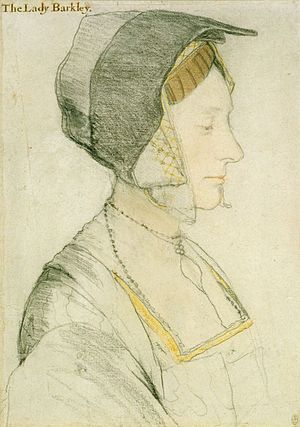Elizabeth Dauncey facts for kids
Quick facts for kids
Elizabeth Dauncey
|
|
|---|---|

Portrait study of Elizabeth Dauncey, 21 years, by Hans Holbein the Younger, c.1527
|
|
| Born |
Elizabeth More
1506 Bucklersbury, St Stephen Walbrook parish, London
|
| Died | 1564, aged 58 |
| Spouse(s) | William Dauncey |
| Parents |
|
| Relatives | Margaret Roper (sister); Cecily Heron (sister) |
Elizabeth Dauncey (born More; 1506–1564) was one of the children of Thomas More. She was part of a group of very smart and educated women. These women were known as "learned ladies" for many years. They were examples for others for the next two centuries.
Contents
Early Life and Education
Elizabeth More was the second child of Thomas More. Her mother was Jane Colte (1488-1511). Her older sister was Margaret (1505-1544). Her younger siblings were Cecily (1507-?) and John (1509-1547).
After his first wife died, Thomas More married Alice Middleton. The family grew to include Alice's daughter. Thomas More also adopted two young women. These were Margaret Giggs and Anne Cresacre (1511–1577). Margaret Giggs later married John Clement, who tutored the family. Anne Cresacre married Elizabeth's brother, John.
Elizabeth and her siblings received a special education. It was based on the humanist tradition. This means they studied classical subjects like Latin and Greek. Their teachers included Thomas More himself and William Gunnell. Other famous thinkers like Nicholas Kratzer (1487? – 1550) also helped.
The More home was a lively place for learning. It was a "model of humanistic interests." It also attracted important scholars like Erasmus. A biographer named George Ballard said Elizabeth learned many languages and sciences. He noted she was very good at them. She even wrote letters to Erasmus. He praised her for her clear Latin writing style.
The poet Mary Scott wrote in the 1700s that the three More sisters were very talented and learned. Thomas More believed his daughters should have the same classical education as his son. This was very unusual for the time. He wrote that girls were "equally suited for those studies." He felt their minds could grow like a field where good seeds are planted. Margaret More, in particular, was one of the most educated women in 16th-century England.
Thomas More's ideas about educating girls were advanced. However, he still believed women should mostly stay at home.
Family Life and Challenges
Elizabeth married William Dauncey on September 29, 1525. William was the son of Sir John Dauncey. Sir John was an important advisor to King Henry VIII.
Elizabeth and William had seven children. Their names were John, Thomas, Bartholomew, William, Germain, Alice, and Elizabeth. They lived in different places. These included Canons Park, Middlesex, and London. Later, after 1543, they lived at Cassiobury, Hertfordshire.
In 1543, Elizabeth's husband and brother faced a difficult situation. They were involved in something called the Prebendaries' Plot. This was an attempt to remove Thomas Cranmer from his important church position. Luckily, they were later forgiven.
Lasting Impact
A famous family portrait was painted by Hans Holbein the Younger. It was called Sir Thomas More and Family (c. 1527). Sadly, this painting was destroyed in a fire in 1752. However, copies were made before that. Rowland Lockey (1565–1616) painted one of these copies in 1592. Lockey's painting shows More's idea of a family that loved learning. Holbein's original studies for the portrait still exist. One of these is a portrait of Elizabeth Dauncey.
Elizabeth Dauncey and her sisters are mentioned in important books. These include George Ballard's Memoirs of several ladies of Great Britain (1752). They are also in Mary Hays's Female Biography, or Memoirs of Illustrious and Celebrated Women of All Ages and Countries (1803). Mary Scott wrote a poem called The Female Advocate (1775). In it, she called the women of the More, Seymour, and Cooke families "a bright assemblage." This means she thought they were a wonderful group of people.
See also
- Collective 18th-century biographies of literary women
- List of women in Female Biography
Images for kids
-
Rowland Lockey (1565–1616), after Hans Holbein the Younger, Thomas More and his family (1592)


